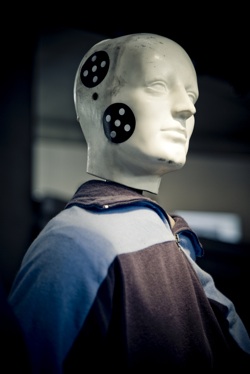A magazine where the digital world meets the real world.
On the web
- Home
- Browse by date
- Browse by topic
- Enter the maze
- Follow our blog
- Follow us on Twitter
- Resources for teachers
- Subscribe
In print
What is cs4fn?
- About us
- Contact us
- Partners
- Privacy and cookies
- Copyright and contributions
- Links to other fun sites
- Complete our questionnaire, give us feedback
Search:
Cognitive crash dummies
by Paul Curzon, Queen Mary University of London

The world is heading for catastrophe. We're hooked on power hungry devices: our mobile phones and iPods, our Playstations and laptops. Wherever you turn people are using gadgets, and those gadgets are guzzling energy - energy that we desperately need to save. We are all doomed, doomed...unless of course a hero rides in on a white charger to save us from ourselves.
Don't worry, the cognitive crash dummies are coming!
Actually the saviours may be people like professor of human-computer interaction, Bonnie John, and her then grad student, Annie Lu Luo: people who design cognitive crash dummies. When working at Carnegie Mellon University it was their job to figure out ways for deciding how well gadgets are designed.
If you're designing a bridge you don't want to have to build it before finding out if it stays up in an earthquake. If you're designing a car, you don't want to find out it isn't safe by having people die in crashes. Engineers use models - sometimes physical ones, sometimes mathematical ones - that show in advance what will happen. How big an earthquake can the bridge cope with? The mathematical model tells you. How slow must the car go to avoid killing the baby in the back? A crash test dummy will show you.
Even when safety isn't the issue, engineers want models that can predict how well their designs perform. So what about designers of computer gadgets? Do they have any models to do predictions with? As it happens, they do. Their models are called 'human behavioural models', but think of them as 'cognitive crash dummies'. They are mathematical models of the way people behave, and the idea is you can use them to predict how easy computer interfaces are to use.
There are lots of different kind of human behavioural model. One such 'cognitive crash dummies' is called 'GOMS'. When designers want to predict which of a few suggested interfaces will be the quickest to use, they can use GOMS to do it.

Send in the GOMS
Suppose you are designing a new phone interface. There are loads of little decisions you'll have to make that affect how easy the phone is to use. You can fit a certain number of buttons on the phone or touch screen, but what should you make the buttons do? How big should they be? Should you use gestures? You can use menus, but how many levels of menus should a user have to navigate before they actually get to the thing they are trying to do? More to the point, with the different variations you have thought up, how quickly will the person be able to do things like send a text message or reply to a missed call? These are questions GOMS answers.
To do a GOMS prediction you first think up a task you want to know about - sending a text message perhaps. You then write a list of all the steps that are needed to do it. Not just the button presses, but hand movements from one button to another, thinking time, time for the machine to react, and so on. In GOMS, your imaginary user already knows how to do the task, so you don't have to worry about spending time fiddling around or making mistakes. That means that once you've listed all your separate actions GOMS can work out how long the task will take just by adding up the times for all the separate actions. Those basic times have been worked out from lots and lots of experiments on a wide range of devices. The have shown, on average, how long it takes to press a button and how long users are likely to think about it first.

GOMS in 60 seconds?
GOMS has been around since the 1980s, but wasn't being used much by industrial designers. The problem is that it is very frustrating and time-consuming to work out all those steps for all the different tasks for a new gadget. Bonnie John's team developed a tool called CogTool to help. You make a mock-up of your phone design in it, and tell it which buttons to press to do each task. CogTool then worked out where the other actions, like hand movements and thinking time, are needed and makes predictions.
Bonnie John came up with an easier way to figure out how much human time and effort a new design uses, but what about the device itself? How about predicting which interface design uses less energy? That is where Annie Lu Luo, came in. She had the great idea that you could take a GOMS list of actions and instead of linking actions to times you could work out how much energy the device uses for each action instead. By using GOMS together with a tool like CogTools, a designer can find out whether their design is the most energy efficient too.
So it turns out you don't need a white knight to help your battery usage, just Annie Lu Luo and her version of GOMS. Mobile phone makers saw the benefit of course. That's why Annie walked straight into a great job on finishing university.


